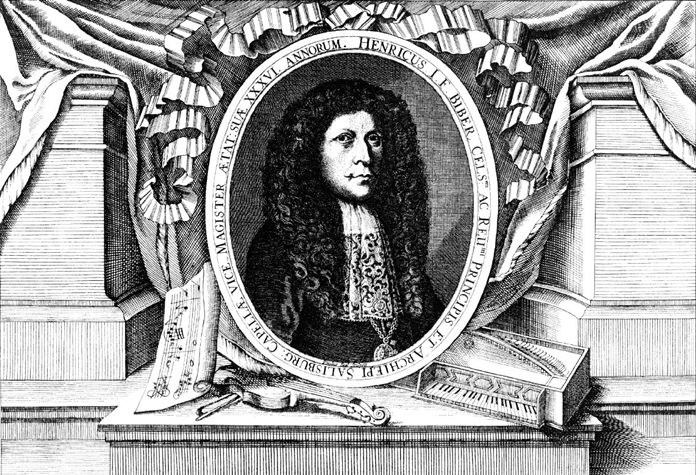Three hundred and seventy-two years ago Heinrich Ignaz Franz von Biber was baptized on 12th August 1644 in the small Bohemian town of Wartenberg. Although he had a modest background, he was to become one of the most important composers for the violin in the history of the instrument. But not only that, Biber (BEE-buh) developed violin playing techniques that were previously unknown.

For example, he was able to reach much higher notes than were previously thought possible, he developed the difficult skill of playing several notes at the same time, a technique known as multiple-stopping. He also experimented with alternative bowing techniques and tunings, enabling the playing of chords on the violin that was previously impossible. And of course, all these brilliant new developments were incorporated into his music for solo violin.
Despite the fact that he gave relatively few concerts, his music was imitated throughout Europe, demonstrating once again that imitation is the sincerest form of flattery.
When Biber was born, it was the musical period now known as the Middle Baroque. The Italian composer Vivaldi was not born until thirty years later and the composers Bach and Handel didn’t see the light of day until 1685. In Biber’s time, composers were often considered no more important than servants. But Biber worked his way up the social and professional ladders and eventually became music director or Kapellmeister to the Archbishop of Salzburg. At the time, you couldn’t get a much better job than that.
A hundred years later, the English music historian Charles Burney wrote “of all the violin players of the last century, Biber seems to have been the best.” There’s no doubt that he was a virtuoso performer who could tackle the most difficult music and even today some of his solo violin pieces are notoriously challenging to perform.
This remarkable work is one of the earliest examples of descriptive music and was one of Biber’s several “representational pieces”. It’s a musical description of a battle and was written in 1683 probably for carnival celebrations at the Salzburg Court. It’s scored for three violins, four violas, cello, double bass and harpsichord continuo. You’ll sometimes see this work referred to as Battalia à 9 or sometimes Battalia à 10 referring to the number of individual instrumental parts, not the number of players. The difference in the numbering depends on whether the continuo is included.
The eight-movement suite is full of musical special effects and novel string techniques some of which were years before their time. In the first movement, string players are instructed to tap the strings with the wood of the bow, an effect known as col legno (“with the wood”). The technique was later used over two hundred years later by Gustav Holst in Mars from The Planets suite.
The second movement (at 01:50) is also two hundred years ahead of its time and features eight popular songs played in different keys anticipating the music of Charles Ives. It is incredibly dissonant and symbolizes a crowd of drunken soldiers dejectedly singing different songs. Later in the work we hear left-hand pizzicato. At one point, the cello imitates a drum and at another, Biber writes in the score that the double bass player must “place a piece of paper on the string” to create the cracking sound of artillery. The bass player is also instructed to pluck the string with such force that it rebounds against the fingerboard, perhaps the earliest historical example of slap bass.
The surprisingly beautiful and moving last movement (at 08:22) gives a picture of a desolate misty battleground littered with dying soldiers. However, despite these dramatic effects which must have raised seventeenth century eyebrows, the work exudes a kind of quaint charm. It’s directed with infectious enthusiasm by violinist Jean-Christophe Spinosi.
Biber didn’t limit himself to music for the violin. He was also a prolific composer of sacred vocal works: masses, requiems and motets. One of his best-known choral works is this resplendent five-movement Requiem in F con terza minore (Requiem in F minor). Composed in 1692 for voices, strings and brass it’s regarded as one of the most original and impressive seventeenth century settings of the requiem mass. From the commanding opening chords the music radiates authority and consummate musical skill.
Biber contrasts solo voices with the choir and with the instruments, using a rich harmonic language and often complex rhythms. The recorded sound is especially compelling and with headphones, you’ll get a wonderful sense of spaciousness. It must have sounded magnificent when it was performed at Salzburg cathedral.
 |
 |
 |





